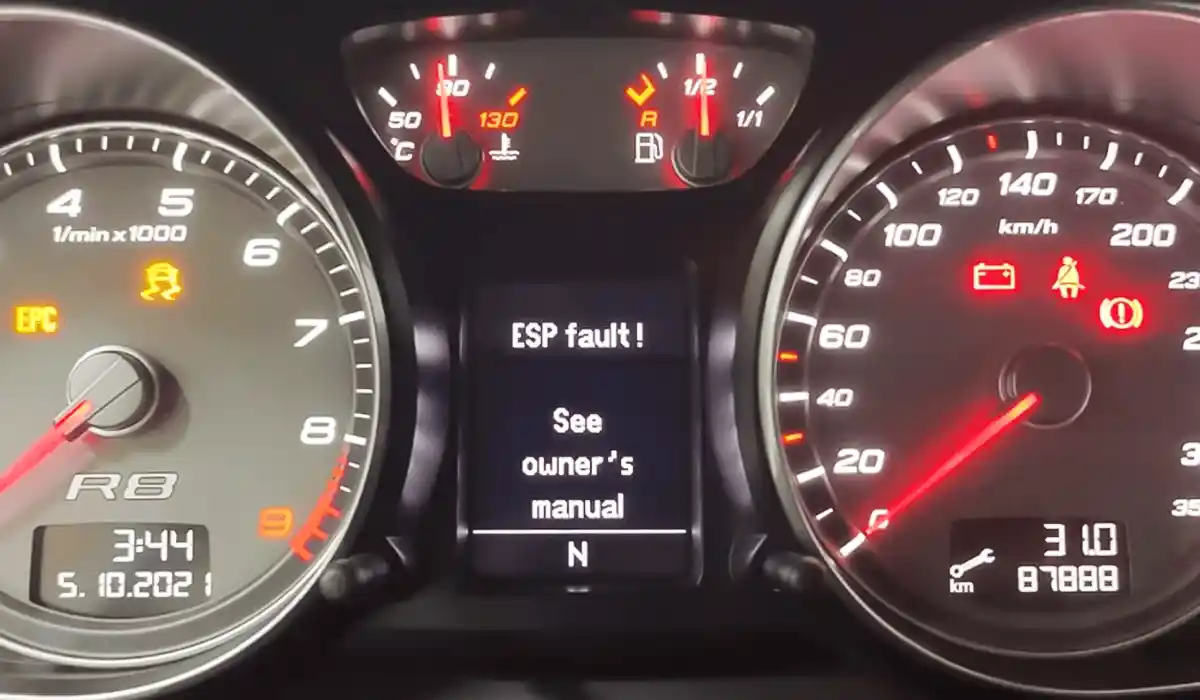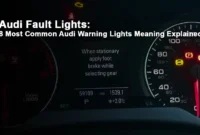Audi ESP Fault in Audi cars has become a widespread and severe problem. Therefore, we need to understand and comprehend the symptoms and solutions to this problem. In this article, we write a complete discussion about the Audi ESP Fault so that it is easy for all parties to understand.
The Electronic Stability Program (ESP) system is an essential safety feature in Audi vehicles. Its primary function is to increase vehicle stability when driving, especially in slippery road conditions or when making sudden manoeuvres.
However, like other electronic components, the ESP system can experience interference or damage, often called an “ESP Fault.” This article will discuss the causes, impacts, and solutions to overcome the ESP Fault problem on Audi vehicles.
Overview: Audi ESP Fault
What is ESP? The Electronic Stability Program (ESP) is a vehicle safety system designed to improve car stability and control, especially when road conditions are slippery or sudden manoeuvres occur. This system controls the brakes individually on each wheel to keep the vehicle stable and follow the driver’s desired direction.
Meanwhile, an ESP Fault indicates a problem with the vehicle’s ESP system. When this system experiences a fault, the ESP warning light on the instrument panel illuminates, usually accompanied by a warning message such as “ESP Fault” or “ESP System Malfunction.”

The ESP system uses various sensors, including wheel speed, steering angle, yaw rate, and electronic control units. These sensors work together to detect potential loss of traction and automatically adjust braking on specific wheels to maintain vehicle stability.
READ NEXT: 2025 Audi Q5: All-New Q5 Exclusive Luxury SUV Reviews
How Does ESP Work on Audi?
ESP on an Audi works by:
- Detecting symptoms of instability: Sensors installed on the vehicle will continuously monitor parameters such as speed, steering angle and tyre slip rate.
- Implement corrective actions: If the system detects symptoms of instability, ESP will automatically take corrective action by reducing engine power and applying the brakes to the wheels as needed to restore vehicle stability.
- Increase traction: ESP also increases vehicle traction, especially when road conditions are slippery.
Benefits of ESP for Audi Drivers
- Improves safety: ESP helps prevent accidents due to loss of vehicle control.
- Increases driving comfort: With ESP, drivers can feel safer and more comfortable when driving, especially in bad weather conditions or uneven roads.
- Improves braking performance: ESP works with the ABS to improve braking performance, resulting in shorter braking distances.
When does ESP work?
- ESP will work automatically when the system detects symptoms of instability, such as:
- Understeer: A condition where the front of the vehicle does not follow the steering direction.
- Oversteer: A condition in which the vehicle’s rear loses traction and tends to slide.
- Loss of traction: For example, one or more wheels lose traction when travelling on a slippery road.
ESP indicator
An ESP indicator light is on an Audi car’s dashboard. This light will light up when the ESP system is active, or there is a problem. If the ESP indicator light is on continuously, you should immediately take your vehicle to an authorized repair shop for inspection.
Audi ESP Fault: Audi ESP Fault Won’t Start
Audi ESP Fault is a problem with Audi cars’ Electronic Stability Control (ESP) system. ESP is a safety feature that helps prevent the vehicle from skidding or losing control. If the ESP light is on, there is a problem with the system, and the car may not function correctly. Cars with ESP problems may be more dangerous to drive and will not pass an MOT test.
When Audi cars are both A3 and A4 models, if you display the error message “ESP Fault” and the car does not turn on, this indicates a serious problem with the vehicle’s electronic system. ESP (Electronic Stability Program) is a safety system that is very important in maintaining vehicle stability while driving. When this system is faulty, the car will refuse to start as a precaution.
Audi ESP Fault Limp Mode
When the Electronic Stability Program (ESP) system in your Audi experiences problems, your car may enter “limp mode.” This mode is an emergency condition in which the car’s performance is limited to prevent further damage. Usually, when an ESP Fault occurs, the ESP indicator light will light up on the dashboard, and the car will feel less responsive when driving.

Top 8 Common ESP Faults Causes and Solutions
- Faulty Wheel Speed Sensor
This sensor is responsible for measuring the rotation speed of each wheel. If one of the sensors is damaged, the ESP system cannot function properly. - Problems with the Steering Angle Sensor
The steering angle sensor measures the position and direction of the steering wheel. If this sensor fails, the ESP control unit will not get accurate data. - Damage to the ESP Module
The ESP module is the brain of this system. If there is a malfunction in the module, the ESP system will not work. - Brake System Problems
The ESP system is very dependent on the braking system. Problems such as insufficient brake pressure or worn brake components can trigger damage to the ESP system. - Weak Battery or Unstable Voltage
ESP systems require a stable power supply. Low voltage or power fluctuations may cause this system to malfunction. - Connection cable
The sensor connection cable to the ESP control module may break, short circuit, or cause other damage. - Uneven tyre pressure
Uneven tyre pressure on all four wheels can affect ESP performance. - Defective suspension components
Damage to suspension components, such as shock absorbers or springs, can disrupt vehicle stability and trigger ESP errors.
Common Causes of Audi ESP Fault Limp Mode
Some common causes that can trigger ESP Fault and cause the car to enter limp mode are:
- Damaged Sensors: Sensors used by the ESP system, such as the wheel speed sensor, steering sensor, and yaw sensor, can become damaged or dirty.
- Connection Cables: The cables connecting the sensor to the ESP control module may break, short circuit, or suffer other damage.
- ESP Control Module: The ESP control module itself can suffer internal damage.
- Uneven Tyre Pressure: Uneven tyre pressure can interfere with ESP performance.
- Brake System Problems: Problems with the brake system, such as worn brake pads or seized callipers, can affect ESP performance.
- Vehicle Modifications: Modifying an inappropriate suspension or brake system may impair ESP performance.
Audi ESP Fault and Limp Mode Symptoms
Apart from the ESP indicator light being on, other symptoms that may appear when an Audi ESP Fault occurs include:
- The vehicle feels unstable when cornering
- The car is difficult to control when driving on slippery roads
- The ABS indicator light also lights up
- The traction control system is not working properly
ESP Fault Limp Mode Symptoms
Apart from the ESP indicator light coming on, other symptoms that may appear when the car enters limp mode include:
- The car feels less powerful
- Steering response feels slow
- The transmission shifts roughly
- Other indicator lights may also come on
Impact of ESP Fault and Limp Mode
When an ESP Fault occurs, the vehicle loses the ability to control stability, especially when road conditions are poor automatically. This can increase the risk of accidents, especially in the following situations:
- When driving on slippery roads due to rain or snow.
- When making sudden manoeuvres to avoid objects on the road.
- When passing a corner at high speed.
Impact ESP Fault Limp Mode
Driving Safety Threatened: A car that enters limp mode will lose most of its performance, which can endanger the driver’s and passengers’ safety.
Repair Cost: Repairing an ESP Fault problem can be expensive, mainly if the damage occurs to a key component such as the ESP control module.
How to Overcome ESP Fault and Limp Mode
To solve the Audi ESP Fault problem, you should immediately take your vehicle to an official Audi repair shop or a trusted specialist repair shop. The technician will perform a diagnosis to find out the exact cause of the problem and make the necessary repairs. Or you can undergo significant checks independently on the following:
- Checking and Replacing Sensors
If the wheel speed sensor or steering angle sensor is damaged, replacing those components will usually fix the problem. - Recalibrate the System
Sometimes, ESP faults can be caused by an improperly calibrated system. Take the vehicle to an authorized repair shop to recalibrate. - ESP Module Inspection
A damaged ESP module may need to be repaired or replaced. This process requires special equipment, usually only available at authorized workshops. - Ensure the Brake System is Functioning Well
Ensure the braking system is in optimal condition, including checking the condition of the brake fluid, discs and brake pads. - Checking Battery Condition
If the battery voltage is unstable, replacing the battery or ensuring the alternator works correctly could be a solution.
How to Overcome Audi ESP Fault Limp Mode
- Take the Car to the Workshop: Take your car to an official Audi repair shop or a trusted specialist repair shop for diagnosis and repair.
- Don’t Do Repairs Yourself: Unless you have sufficient knowledge about car electronic systems, it is best not to try to fix the ESP Fault problem yourself.
Audi ESP Fault Prevention
To prevent ESP Fault problems, perform routine maintenance on your vehicle, including:
- Check the brake system regularly.
- Ensure all sensors are in good condition.
- Using genuine Audi spare parts.
- Carry out routine checks at an authorized repair shop.
Apart from that, several significant things can help you do the following:
- Check tyre pressure regularly: Make sure the tyre pressure is always within the manufacturer’s recommendations.
- Keep suspension components in good condition: Perform regular servicing according to the recommended schedule.
- Check the brake system regularly: Ensure the brake linings and other components are in good condition.
- Avoid modifications that may interfere with ESP performance. For example, Modifications to the suspension or brake system may affect ESP performance.
Verdict
Audi ESP faults must be addressed immediately because they can endanger your safety and that of our passengers. This is very serious and can affect driving safety. By understanding the causes and impacts and how to overcome them, you can immediately take appropriate action when facing this problem. Don’t hesitate to take your vehicle to an official Audi repair shop for professional and reliable handling.
With a deeper understanding of the ESP Fault, you can now take the proper steps to maintain your Audi’s performance. We’ll be back shortly with more information on the ESP Fault, so bookmark the Audi Car USA website for the latest Audi Guide and other future Audi updates.
FAQs: People also ask about Audi ESP Fault
Q: How do I clear my ESP fault?
A: A reset can be somewhat easy if the ESP® warning light is on and stays lighted. Different models will call for different approaches, but generally the method is as follows: Find the "ESp® Off" button. Press and hold the button five seconds.
Q: Is it OK to drive with ESP light on?
A: Usually, a warning light on your Electronic Stability Program (ESP) indicates either a malfunction with your system or that you are driving on a slick surface.
Q: What causes ESP fault?
A: Traction loss, defective sensors, brake system problems, faulty ABS system, wrong wheel alignment, low tyre pressure, broken wiring or connectors, damaged batteries, corrupted software, and bald tyres are all typical reasons the ESP light turns on.
Q: Where is the ESP sensor located?
A: Where Usually Found the ESP Sensor? Usually installed someplace close to the center of the vehicle, the Electronic Stability Program (ESP) sensor can offer the most accurate data. The ESP sensor is a safety mechanism designed to assist a motorist in challenging conditions.
